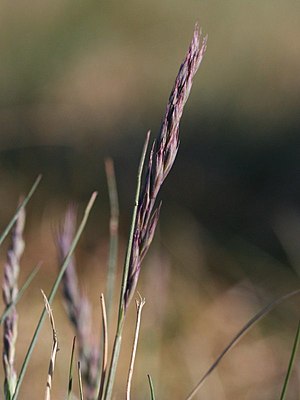Predatory sheep fescue
| Predatory sheep fescue | ||||||||||||
|---|---|---|---|---|---|---|---|---|---|---|---|---|

Predatory sheep fescue ( Festuca brevipila ) |
||||||||||||
| Systematics | ||||||||||||
|
||||||||||||
| Scientific name | ||||||||||||
| Festuca brevipila | ||||||||||||
| R.Tracey |
The Raublättrige sheep fescue ( Festuca brevipila , Syn. : F. trachyphylla , F. stricta . Subsp trachyphylla ), also called Raublatt fescue called, belongs to the group of species of sheep fescue ( Festuca ovina within the family of agg.) Grasses ( Poaceae).
Distribution and location
The predatory sheep fescue is a species common in Central Europe. It occurs from the plains to heights of around 200 meters in Austria, Belgium, the Czech Republic, the Netherlands, Germany, Poland and Switzerland. It mainly inhabits lime-poor to acidic, low-nitrogen sandy soils in dry sand , but also short-lived ruderal meadows and fresh meadows and pastures. It is often used in seed mixtures for park and shear lawns. From there it was widely abducted and is now often found on roadsides, in embankments, on railway embankments and in port facilities.
features
The fescue fescue is a deciduous, perennial hemicryptophyte . The clump-growing, herbaceous plant reaches heights of between 10 and 70 centimeters. The mostly gray-green and slightly frosted or unripened and dark green, rush-shaped leaves are rough with a V-shaped cross-section. They measure around 0.7 to 0.9 millimeters in diameter. The formation of the sclerenchyma is variable. The leaf blades are seven to thirteen nerved. Sometimes they have three vascular bundles in the middle and on the edges. Sometimes there are intermediate bundles that can flow together in a ring. The leaf sheaths are also hairy rough to closely spaced apart.
The inflorescence is a loose or otherwise contracted panicle at flowering time , which is 4 to 12 centimeters long. The spikelets reach 6 to 10 millimeters, the often reddish overflowing lemmas 4 to 6 millimeters in length. The husks carry a 2 to 3 millimeter long awn. The blooming time of the fescue is in the morning between May and July.
The number of chromosomes is 2n = 42.
Individual evidence
- ↑ Jürgen Dengler: Standard list of the narrow-leaved fescue clans (Festuca ovina agg. And F. rubra agg.) In Germany , version of March 6, 2000 PDF
- ^ Erich Oberdorfer : Plant-sociological excursion flora for Germany and neighboring areas . 8th edition. Stuttgart, Verlag Eugen Ulmer, 2001. ISBN 3-8001-3131-5 . Page 216.
literature
- Henning Haeupler , Thomas Muer: picture atlas of the fern and flowering plants of Germany (= the fern and flowering plants of Germany. Volume 2). Published by the Federal Agency for Nature Conservation. Ulmer, Stuttgart 2000, ISBN 3-8001-3364-4 .
- CE Hubbard: Grasses - description, distribution, use Ulmer Verlag, Stuttgart 1985, ISBN 3-8001-2537-4
- E. Oberdorfer: Plant-sociological excursion flora. Ulmer, Stuttgart 1994, ISBN 3-8252-1828-7
Web links
- Festuca brevipila Tracey at FloraWeb
- Distribution in Europe
- Distribution in Germany
- Festuca brevipila R. Tracey, map for distribution in Switzerland In: Info Flora , the national data and information center for Swiss flora .

